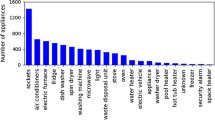Abstract
In the future, the foreseen increase of residential electricity consumption will force the Distribution System Operators to reinforce their networks at great expense. Through the emergence of ICT solutions and the increase of electric consumption flexibility at residential level, peak shaving has become an interesting alternative for reducing the investment costs in a distribution grid facing a load increase. This can be achieved with energy management systems (EMS) installed at residential level. Specifically, this work aims at considering peak shaving as an alternative to network reinforcement in a 20-year distribution planning study. For this purpose, the present work incorporates an optimal peak shaving approach to an accurate Convex DistFlow-based planning approach. Based on this, it quantifies how peak shaving can economically compete with network reinforcements for 12 real UK distribution networks under various flexibility scenarios. The results highlight that peak shaving is a competitive alternative to line reinforcement if the maximum initial line loading at the initial year of the planning study is under 80% of its nominal thermal rating value. It is also shown that EMS devices with a cost between 10 and 250 £/unit are economically competitive with network reinforcements depending on the considered network. Finally, this work proposes a planning decision metric, the initial line loading (ILL), measured at the beginning of the planning study, on the basis of which reinforcement decisions can be made.



Similar content being viewed by others
Notes
This document and all the related network data (load profiles, network connectivity and line data) are publicly available at https://www.researchgate.net/publication/283569482_Dissemination_Document_Low_Voltage_Networks_Models_and_Low_Carbon_Technology_Profiles.
A. Navarro-Espinosa, Centro de Energia, FCFM, Universidad de Chile.
References
Element Energy Limited: Further analysis of data from the household electricity usage study: correlation of consumption with low carbon technologies. In: Final report for Department of Energy and Climate Change and Department for the Environment Food and Rural Affairs (2014)
Ganguly, S., Sahoo, N.C., Das, D.: Recent advances on power distribution system planning: a state-of-the-art survey. Energy Syst. 4, 165–193 (2013)
Molzahn, D.K., Hiskens, I.A.: A survey of relaxations and approximations of the power flow equations. Found, Trends Electr Energy Syst (2017)
Farivar, M., Clarke, C.R., Low, S.H., Chandy, K.M.: Inverter VAR control for distribution systems with renewables. In: 2011 IEEE International Conference on Smart Grid Communications (SmartGridComm), pp. 457–462 (2011)
Gan, L., Li, N., Topcu, U., Low, S.H.: Exact convex relaxation of optimal power flow in radial networks. IEEE Trans. Autom. Control 60(1), 72–87 (2015)
Martin, B., De Rua, P., De Jaeger, E., Glineur, F.: Loss reduction in a windfarm participating in primary voltage control using an extension of the Convex DistFlow OPF (Forthcoming). In: 20th Power Systems Computation Conference, (Dublin) (2018)
Ochoa, L., Dent, C., Harrison, G.: Distribution network capacity assessment: variable DG and active networks. IEEE Trans. Power Syst. 25, 87–95 (2010)
Dugan, R.C., McDermott, T.E., Ball, G.J.: Distribution planning for distributed generation. In Rural Electric Power Conference, IEEE, pp. C4–1 (2000)
Poudineh, R., Jamasb, T.: Distributed generation, storage, demand response and energy efficiency as alternatives to grid capacity enhancement. Energy Policy 67, 222–231 (2014)
Neimane, V.: On development planning of electricity distribution networks. PhD thesis, Royal Institute of Technology, Department of Electrical Engineering, Stockholm (2001)
Pilo, F., Jupe, S., Abbey, C., Baitch, A., Bak-Jensen, B., Carter-Brown, C., Celli, G., El Bakari, K., Fan, M., Georgilakis, P., Hearne, T., Ochoa, L., Petretto, G., Taylor, J.: Planning and optimization methods for active distribution systems. CIGRE, C6.19 working group
Gemine, Q., Ernst, D., Cornlusse, B.: Active network management for electrical distribution systems: problem formulation, benchmark, and approximate solution, (2014). ArXiv preprint arXiv:1405.2806
Uddin, M., Romlie, M.F., Abdullah, M.F., Abd Halim, S., Abu Bakar, A.H., Chia Kwang, T.: A review on peak load shaving strategies. Renew. Sustain. Energy Rev. 82, 3323–3332 (2018)
Pimm, A.J., Cockerill, T.T., Taylor, P.G.: The potential for peak shaving on low voltage distribution networks using electricity storage. J. Energy Storage 16, 231–242 (2018)
Reihani, E., Motalleb, M., Ghorbani, R., Saoud, L.S.: Load peak shaving and power smoothing of a distribution grid with high renewable energy penetration. Renew. Energy 86, 1372–1379 (2016)
Adika, C., Wang, L.: Smart charging and appliance scheduling approaches to demand side management. Int. J. Electr. Power Energy Syst. 57, 232–240 (2014)
Oudalov, A., Cherkaoui, R., Beguin, A.: Sizing and optimal operation of battery energy storage system for peak shaving application. In: 2007 IEEE Lausanne Power Tech, pp. 621–625 (2007)
Rahimi, A., Zarghami, M., Vaziri, M., Vadhva, S.: A simple and effective approach for peak load shaving using battery storage systems. In: 2013 North American Power Symposium (NAPS), pp. 1–5 (2013)
Molderink, A., Bakker, V., Bosman, M.G.C., Hurink, J.L., Smit, G.J.M.: Domestic energy management methodology for optimizing efficiency in Smart Grids. In: 2009 IEEE Bucharest PowerTech, pp. 1–7 (2009)
Alam, M.J.E., Muttaqi, K.M., Sutanto, D.: A controllable local peak-shaving strategy for effective utilization of PEV battery capacity for distribution network support. IEEE Trans. Ind. Appl. 51, 2030–2037 (2015)
Wang, Z., Wang, S.: Grid power peak shaving and valley filling using vehicle-to-grid systems. IEEE Trans. Power Deliv. 28, 1822–1829 (2013)
Mets, K., Verschueren, T., Turck, F., Develder, C.: Exploiting v2g to optimize residential energy consumption with electrical vehicle (dis)charging. In: 2011 IEEE First International Workshop on Smart Grid Modeling and Simulation (SGMS) (2011)
Feron, B.: An agent based approach for virtual power plant valuing thermal flexibility in energy markets. In: IEEE Powertech (2017)
Molitor, C.: Residential city districts as flexibility resource analysis simulation and decentralized coordination algorithms. PhD Thesis (2015)
Herter, K.: Residential implementation of critical-peak pricing of electricity. Energy Policy 35, 2121–2130 (2007)
Yu, T., Kim, D.S., Son, S.-Y.: Optimization of scheduling for home appliances in conjunction with renewable and energy storage resources. Int. J. Smart Home 7(4), 261–272 (2013)
Zhao, Z.: An optimal power scheduling method applied in home energy management system based on demand response. ETRI J. 35, 677–686 (2013)
Mohsenian-Rad, A.-H., Leon-Garcia, A.: Optimal residential load control with price prediction in real-time electricity pricing environments. IEEE Trans. Smart Grid 1(2), 120–133 (2010)
Mathieu, J.: Modeling, analysis, and control of demand response resources. PhD thesis, University of California, Berkeley (2012)
Martin, B., De Jaeger, E., Glineur, F.: A comparison of convex formulations for the joint planning of microgrids. CIRED-Open Access Proc. J. (2017)
Ben-Tal, A., Nemirovski, A.: On polyhedral approximations of the second-order cone. Math. Oper. Res. 26(2), 193–205 (2001)
Navarro-Espinosa, A., Ochoa, L.F.: Probabilistic impact assessment of low carbon technologies in LV distribution systems. IEEE Trans. Power Syst. 31, 2192–2203 (2016)
Espinosa, A.N.: Dissemination document low voltage networks models and low carbon technology profiles. Technical report, University of Manchester and Electricity North West Limited, UK (2015)
Electricity North West Limited: Statement of methodology and charges for connection of Electricity North West Limited’s electricity distribution. Tech, Rep (2015)
Acknowledgements
The authors gratefully acknowledge BMBF (German Federal Ministry of Education and Research) for providing financial support, promotional reference 13N13297.
Author information
Authors and Affiliations
Corresponding author
Rights and permissions
About this article
Cite this article
Martin, B., Feron, B., De Jaeger, E. et al. Peak shaving: a planning alternative to reduce investment costs in distribution systems?. Energy Syst 10, 871–887 (2019). https://doi.org/10.1007/s12667-018-0299-3
Received:
Accepted:
Published:
Issue Date:
DOI: https://doi.org/10.1007/s12667-018-0299-3




